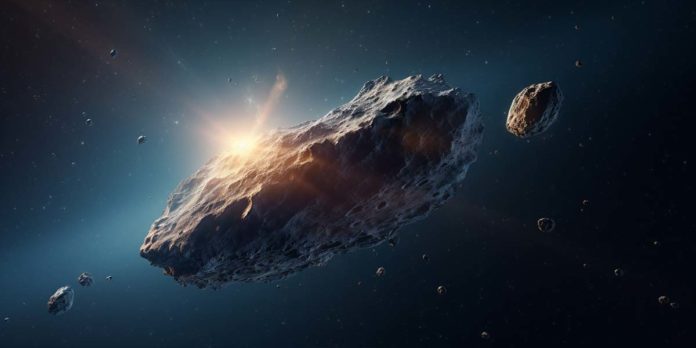
The cosmos has always been a vast source of mystery and fascination, but a recent study reported by Space has added a new layer of intrigue to our celestial neighbourhood.
Asteroid 33 Polyhymnia is part of the main belt between Mars and Jupiter, and unlike the meteor that hit Texas, it is not coming anywhere close to the Earth any time soon. Despite that, it has piqued the interest of scientists due to its extraordinary density.
This finding suggests that the asteroid could contain elements that are not only beyond the current periodic table but also offer insights into the very fabric of the universe.
Beyond the Periodic Table: Superheavy Elements in Space
The periodic table, comprising 118 chemical elements, is the cornerstone of chemistry and the blueprint for the material universe as we understand it. However, researchers have stumbled upon evidence that challenges this comprehensive catalogue.
The density of certain asteroids, like 33 Polyhymnia, has prompted scientists to propose the existence of naturally occurring “superheavy elements.” These elements are theorized to be denser than osmium, the heaviest element naturally found on Earth, and could potentially be stable enough not to decay as quickly as previously thought.
This groundbreaking hypothesis emerges from the latest research, which suggests that these superheavy elements could explain the confounding weight of 33 Polyhymnia and similar celestial bodies, known as compact ultra-dense objects (CUDOs).
The study, led by Professor Johann Rafelski from the University of Arizona, offers a new perspective on the composition of these dense space rocks, shifting the focus from dark matter to the possibility of entirely new classes of chemical elements.
The Island of Stability: A Theoretical Haven for New Elements
The concept of an “island of stability” has floated around scientific circles for some time, positing that the periodic table might extend beyond the currently known elements into a realm where superheavy elements could exist without immediate decay.
These elements, with atomic numbers around 164, could theoretically resist the rapid radioactive decay that plagues lighter superheavy elements, owing to the repulsion between the large numbers of protons in their nuclei. Rafelski’s team, utilizing the Thomas-Fermi model, mathematically demonstrated that such elements could indeed have a density corresponding with that of 33 Polyhymnia.
The “island of stability” offers a tantalizing hint at the possibility of discovering new materials within our own solar system. If these elements can be found and studied, it could revolutionize our understanding of chemical processes and material properties, potentially leading to advances in technology and industry.
Charting the Unseen: The Role of Dark Matter in Celestial Density
While the theory of superheavy elements is compelling, the scientific community remains cautious. Dark matter, an elusive substance that does not emit, absorb, or reflect light, has been a longstanding candidate for explaining the anomalous density of CUDOs. Although this new study leans towards the existence of superheavy elements, it does not completely rule out the presence of dark matter within these dense cosmic bodies.
The intersection of the study of superheavy elements and dark matter could open up new pathways in astrophysics and cosmology. Should further research validate the presence of these elements, it would not only redefine the boundaries of the periodic table but also provide a new window into the understanding of dark matter and its role in the universe.
The Future of Space Exploration: A New Frontier
The implications of this research extend beyond academia into the realm of space exploration and materials science. The potential discovery of superheavy elements within asteroids like 33 Polyhymnia could spur a new era of space mining, with these elements serving as valuable resources for future technological advancements.
In conclusion, the high density of 33 Polyhymnia might be a beacon leading us to uncharted territories of the periodic table and beyond. The hypothesis of superheavy elements, supported by recent mathematical models, challenges current scientific understanding and opens up a universe of possibilities.
Whether these findings will lead to the discovery of new materials or a deeper understanding of dark matter remains to be seen. But one thing is certain: the cosmos continues to hold secrets that beckon us to explore and unravel the mysteries of existence.









